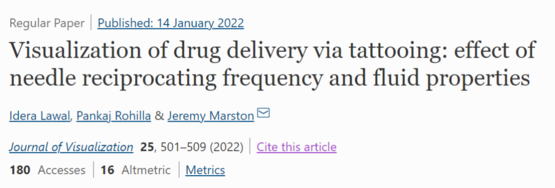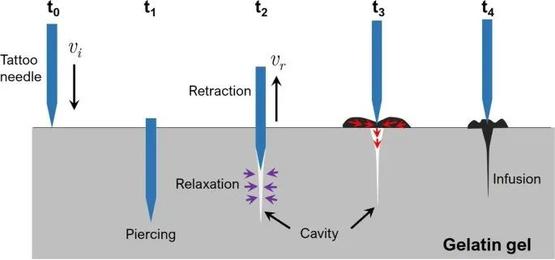Lawal is a PhD candidate in the Chemical Engineering Department of the Texas Tech College of Engineering. As part of his doctoral qualification exam, he had six weeks to design a project to study the physics of intradermal drug delivery using a tattoo device. He’s always been interested in tattoos, so the job came at the right time.
“I was interested in it because I didn’t know people were really working on tattoos,” he said. “I don’t have tattoos myself, but I thought tattoos were cool. So, I was like, ‘Okay, I’m going to join in. ‘ Even after finishing the project, I continued to work until the final paper was published.”
The paper, which investigates the physics underlying the tattooing process using high-speed imaging techniques, was published in the Journal of Visualization in January. In March, Lawal presented his research at a meeting of the American Physical Society, accompanied by a video showing his work.

“Because the needle moves very, very fast, the injection speed varies from 46 stitches per second to 200 stitches per second,” Lawal explained. “So in the lab, we use a high-speed camera to reproduce the process at low speed, recording every One injection. Using the skin model was able to see how this ink got into the skin and what was the mechanism that drives it.”
While there have been past studies exploring the potential of tattooing as a drug injection technique, little is known about the fluid dynamics involved in the tattooing process. Lawal’s research provides a different method of delivering fluids that could provide a practical way for future vaccinations.
So how do tattoo injections work?
As it stands today, vaccines are usually administered subcutaneously. A hollow needle is used to pierce the skin into the muscle, and then the syringe is depressed, and the fluid enters the body through the hollow tube of the needle.
And tattoo needles work differently. Tattoo needles are not hollow and do not divert fluids, but are immersed in ink. Unlike hypodermic needles, the purpose of tattoo needles is not to pierce the muscle, but the skin. When the tattoo needle is retracted, the small puncture wound created by the micro-creation begins to close, and the ink soaking the needle also fills the wound.

How tattoo needles work | Reference [2]
Using a high-speed camera, Lawal was able to demonstrate exactly how the ink is delivered and how the body’s largest organ, the skin, responds. It is this response that could lead to a medical breakthrough.
” When a tattoo is over, there are hundreds or thousands of tiny scars on the skin, all caused by these tiny needles,” Lawal said. “This causes an inflammatory response from the immune system and a flood of immune cells. ” Injury attracts immune cells to the injury site, including dermal immune cells called fibroblasts.
“Immune cells are always on patrol, and as soon as they spot a foreign body and bind to its antigen, they signal that more immune cells flood into the location. This ostensibly occurs at the site of micro-injury and is also an enhanced immune response. s reason.”
Lawal’s research also looked at the viscosity of the injected fluid, an important factor in whether tattoo needles could be popularized in the medical field in the future. Because in the medical field, DNA vaccines are usually very viscous and cannot be administered by intramuscular injection. The ability of tattoo needles to apply multiple small punctures to a larger area of skin may make them potentially used in the field of vaccines in the future. A wider range of administration and feedback from the human immune system may be able to reduce injection doses and reduce side effects.
references
[1] https://ift.tt/GLw7VSv
[2] Lawal, I., Rohilla, P. & Marston, J. Visualization of drug delivery via tattooing: effect of needle reciprocating frequency and fluid properties. J Vis 25, 501–509 (2022). https://ift. tt/qFg5p7N
Compilation: Oasis
Editor: Jin Xiaoming
Typesetting: Yin Ningliu
Title image source: Pixabay
research team
Corresponding author Pankaj Rohilla: Ph.D., School of Engineering, Texas Tech University
Corresponding author Jeremy Marston: Ph.D., School of Engineering, Texas Tech University
Group homepage
https://ift.tt/7YFcjNi
First author Idera Lawal: Ph.D., School of Engineering, Texas Tech University
Paper information
Publish Journal of Visualization
Posted January 14, 2022
Paper titleVisualization of drug delivery via tattooing: effect of needle reciprocating frequency and fluid properties
(DOI: https://ift.tt/UCzO8LI)
The Future Light Cone Accelerator is an early-stage technology entrepreneurship accelerator initiated by Nutshell Technology. It provides scientists with solutions at different stages ranging from company registration, intellectual property rights, to financing needs, and team formation. Accelerate the transformation of scientific and technological achievements from the laboratory to the market, and accelerate the iteration of some scientists to become CEOs.
The Nutshell team has 12 years of experience in serving scientists. We always make suggestions from the perspective of scientists and be good friends of science and technology creators. If you are planning to start a technology business, whether you are looking for money, people, resources, or orders, you are welcome to chat with the Future Light Cone team. You can send bp or other project information to [email protected] , and leave your contact information, or add the Wechat of Guoke Hard Technology Enterprise to communicate by private message.

✦
✦
Click to read the original text to view the original paper
This article is reproduced from: http://www.guokr.com/article/462378/
This site is for inclusion only, and the copyright belongs to the original author.